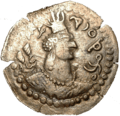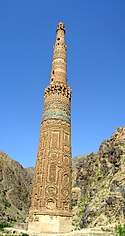Turk Shahi
Türk Şahiler | |||||||||||||
|---|---|---|---|---|---|---|---|---|---|---|---|---|---|
| 665–850 | |||||||||||||
 Tamga of the Turk Shahi
| |||||||||||||
 Lands of the Turk Shahi in 700 AD, after the secession of Zabulistan. | |||||||||||||
| Capital | Kabul | ||||||||||||
| Religion | Buddhism | ||||||||||||
| Tegin | |||||||||||||
• 665 - 680 | Barha Tegin | ||||||||||||
• 680 - c. 730 | Khorasan Tegin Shah | ||||||||||||
• ? - c. 850 | Lagaturman | ||||||||||||
| Historical era | Early Middle Ages | ||||||||||||
• Established | 665 | ||||||||||||
• Disestablished | 850 | ||||||||||||
| |||||||||||||
| Today part of |
| ||||||||||||
Pre-14th century | |||||||
|---|---|---|---|---|---|---|---|
| Turkic Khaganate 552–744 | |||||||
| Western Turkic | |||||||
| Eastern Turkic | |||||||
| Khazar Khaganate 618–1048 | |||||||
| Xueyantuo 628–646 | |||||||
| Great Bulgaria 632–668 | |||||||
| Danube Bulgaria | |||||||
| Volga Bulgaria | |||||||
| Kangar union 659–750 | |||||||
| Turk Shahi 665–850 | |||||||
| Turgesh Khaganate 699–766 | |||||||
| Uyghur Khaganate 744–840 | |||||||
| Karluk Yabgu State 756–940 | |||||||
| Kara-Khanid Khanate 840–1212 | |||||||
| Western Kara-Khanid | |||||||
| Eastern Kara-Khanid | |||||||
| Ganzhou Uyghur Kingdom 848–1036 | |||||||
| Qocho 856–1335 | |||||||
| Pecheneg Khanates 860–1091 |
Kimek confederation 743–1035 | ||||||
| Cumania 1067–1239 |
Oghuz Yabgu State 750–1055 | ||||||
| Ghaznavid Empire 963–1186 | |||||||
| Seljuk Empire 1037–1194 | |||||||
| Sultanate of Rum | |||||||
| Kerait khanate 11th century–13th century | |||||||
| Khwarazmian Empire 1077–1231 | |||||||
| Naiman Khanate –1204 | |||||||
| Qarlughid Kingdom 1224–1266 | |||||||
| Delhi Sultanate 1206–1526 | |||||||
| Mamluk dynasty | |||||||
| Khalji dynasty | |||||||
| Tughlaq dynasty | |||||||
| Golden Horde | [1][2][3] 1240s–1502 | |||||||
| Mamluk Sultanate (Cairo) 1250–1517 | |||||||
| Bahri dynasty | |||||||
|
Other Turkic dynasties
in Anatolia | |||||||
The Turk Shahi (Turkish: Türk Şahiler) were a Turkic dynasty that ruled from Kabul and Kapisa in the 7th to 9th centuries. The replaced the Nezak – the last dynasty of Bactrian rulers with origins among the Xwn (Xionite) and/or Huna peoples (who are sometimes also referred to as "Huns", under the controversial belief that they were linked to Huns that invaded Eastern Europe during a similar period).
Kabulistan was the heartland of the Turk Shahi domain, which at times included Zabulistan.[4] and Gandhara.
During their rule, the Turk Shahi were an obstacle to the eastward expansion of the Abbasid Caliphate.
The last Shahi ruler of Kabul, Lagaturman, was deposed by a Brahmin minister in c. 850, signaling the end of the Buddhist Turk Shahi dynasty, and the beginning of the Hindu Shahi dynasty of Kabul.[5]
Coinage

_of_the_Nezac_Huns_680-738.jpg) "Sri Shahi", royal title of the Turk Shahi (680-738).[6]
"Sri Shahi", royal title of the Turk Shahi (680-738).[6] Turk Shahi ruler, early 8th century CE.
Turk Shahi ruler, early 8th century CE.
References
- ↑ Marshall Cavendish Corporation (2006). Peoples of Western Asia. p. 364.
- ↑ Bosworth, Clifford Edmund (2007). Historic Cities of the Islamic World. p. 280.
- ↑ Borrero, Mauricio (2009). Russia: A Reference Guide from the Renaissance to the Present. p. 162.
- ↑ "15. The Rutbils of Zabulistan and the "Emperor of Rome"". Pro.geo.univie.ac.at. Retrieved July 22, 2017.
- ↑ "16. The Hindu Shahis in Kabulistan and Gandhara and the Arab conquest". Pro.geo.univie.ac.at. Retrieved July 22, 2017.
- ↑ CNG Coins
